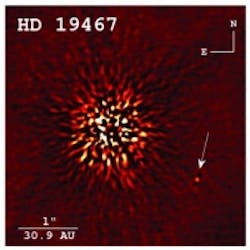Keck I telescope captures image of rare brown dwarf
Using the imaging instruments on the Keck I telescope, a team of researchers has captured an image of a rare type of brown dwarf that may serve as a benchmark for studying objects with masses that lie between stars and planets.
In this research, which was published in a recent issue of Astrophysical Journal, it is explained that initial data came from the TRENDS (Targeting benchmark objects with Doppler Spectroscopy) high-contrast imaging survey, which uses adaptive optics and related technologies to target older, faint objects orbiting nearby stars. Precise measurements were made at the W.M Keck Observatory in Mauna Kea, Hawaii, where the Keck I telescopes HIRES instrument provided radial velocity measurements. HIRES consists of two cameras, a short-focus camera for resolutions up to 50,000 and another camera for resolutions up to 200,000. HIRES—the largest and most complex of the Keck’s main instruments—features Tektronix 2,048 x 2,048 CCD detectors with 24 µm x 24 µm pixel size and is capable of operating between 0.3 µm and 1.0 µm.
The observations obtained with the HIRES instrument began in 1996, and show a long-term acceleration, including that a low-mass companion was "tugging" on a parent star. Following imaging observations were taken in 2012 using the Keck I’s near infrared camera (NIRC2), which works with the Keck adaptive optics system to produce high-resolution ground-based images and spectroscopy in the 1 µm to 5 µm range. NIRC2’s detector is a 1,024 x 1,024 Aladdin-3 array with 27 µm x 27 µm pixel size. It features a wavelength range of 0.9 µm to 5.3 µm. The discovery of the brown dwarf, which was named HD 19467 B, could be a step towards a fuller understanding of exoplanets, according to a Keck Observatory press release.
"This object is old and cold and will ultimately garner much attention as one of the most well-studied and scrutinized brown dwarfs detected to date," Justin R. Crepp, team leader and Freimann Assistant Professor of Physics at the University of Notre Dame said. "With continued follow-up observations, we can use it as a laboratory to test theoretical atmospheric models."
He added, "Eventually we want to directly image and acquire the spectrum of Earth-like planets. Then, from the spectrum, we should be able to tell what the planet is made out of, what its mass is, radius, age, etc., basically all relevant physical properties."
View the Keck Observatory press release.
Also check out:
Spectrograph finds three new planets in Messier 67 star cluster
Gemini Planet Imager captures photo of planet 63 light years from Earth
2013 highlights in vision: Aerospace imaging
Share your vision-related news by contacting James Carroll, Senior Web Editor, Vision Systems Design
To receive news like this in your inbox, click here.
Join our LinkedIn group | Like us on Facebook | Follow us on Twitter | Check us out on Google +
About the Author

James Carroll
Former VSD Editor James Carroll joined the team 2013. Carroll covered machine vision and imaging from numerous angles, including application stories, industry news, market updates, and new products. In addition to writing and editing articles, Carroll managed the Innovators Awards program and webcasts.
